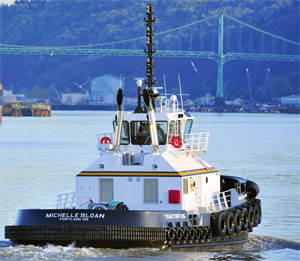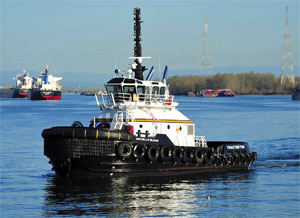California’s San Pedro Bay ports are an ideal example of “super size me.” Each year, neighbors and rivals Los Angeles and Long Beach ports must handle ever-bigger containerships, way beyond what was projected 10 years ago. And with this seemingly endless succession of monster ships calling, Millennium Maritime, a subsidiary of Harley Marine, is among the seven tug companies servicing the two ports being called on to provide more powerful, yet environmentally friendly, ship-handling and assist boats.
Harley’s latest additions are Michelle Sloan and Lela Franco, RAmparts 2500 designs, based on the John Quigg and the Tim Quigg designs by Robert Allan in 2004 but modified and larger. Michelle was already in service in the spring while Lela was due in the summer.
It’s a small wonder that bigger tugs are called for. Consider that in 2004 the average oceangoing vessel serving Southern California, according to consultant Mercator Transport Group, was 3,700 TEU, while this year 14,000-TEU ships are calling regularly. Those ships have increased in length from 800 feet to 1,500 feet.
The 2004 tugs are 80 feet by 32 feet, while the new pair are 80 feet by 36 feet. The twin Caterpillar 3516C diesel engines are each rated 2,575 bhp at 1,600 rpm, producing 5,150 hp and driving a 94.5-foot-diameter fixed-pitch propeller. They’re essentially the same tug producing more. Generators are two Tier 3 125-kW John Deere 6068s.
“The cutting-edge engines reduce NOx and particulate matter by 74 percent compared with Tier 2,” Robert Allan said in a news release. “This reinforces both Harley Marine and Caterpillar’s commitment to being environmentally responsible industry leaders.”
Like the 2004 vessels, Michelle and Lela have been built at the open-air yard of Diversified Marine in Portland, Ore. Ten changes have been made to the new boats, relating to better emissions control, modern electronics, propulsion drives and a stronger structure. The recent vessels contain Rolls-Royce US205 z-drives compared with Aquamaster 1350 on the 2004 craft.
“They are a bit heavier and stronger,” said Jim Hyslop, Robert Allan’s manager of project development. “We have redesigned the skeg profile to suit a more escort type of vessel. These designs are pretty much suitable for any waters, except perhaps the Arabian Gulf because of the much greater temperatures.”
There are accommodations for six, although the normal crew complement is two. Soundproofing includes insulated flooring and NORAC wallboard from Norway.
Sea trials were flawless, using 6,000 gallons as ballast with negligible vibration. Onlookers applauded when Michelle Sloan docked.
 |
|
Michelle Sloan |
|
Courtesy Harley Marine |
Bollard pull trials were held in California. The results were 69/71.3 short tons ahead and 65.4/67.4 short tons astern. Free running speed ahead was 12.5 knots. Marcus Babani, Harley’s marketing coordinator, called the results “higher than what was originally expected” and described the ahead pull as “staggering.”
Significant new features of Michelle Sloan and its sister are the Markey DEPC-48 50-hp hawser winch and DEPC-32 20-hp aft deck winch.
The DEPC-48 electric hawser winch, with encoder for continuous stall capability and designed for lead line off the top of the drum, has a drum capacity for 500 feet of 9-inch Spectra line and a rated performance of 28,000 pounds at 54 feet per minute. The air-set and air-released brake is capable of holding 612,900 pounds. The render/recover feature allows the operator to render and recover line at adjustable tension, within high-speed range.
“This feature allows the captain to keep both hands, and 100 percent of his attention, on the controls and the assisted vessel while maneuvering or repositioning the tug,” Markey said in a statement. “When it is time for the tug to apply steering force, the captain has only to set the main drum brake.”
Another feature is the ability to dampen drum motion while freewheeling and operate the clutch automatically by reacting to drum speed. “Tethered higher-speed tug maneuvers can be accommodated without the need for the tug operator to manually clutch out and clutch back in, further enabling hand-free operation of the winch and enhancing safer tug operations,” Markey wrote.
A wheelhouse display shows the line tension when the drum brake is set. The aft winch runs on a 20-hp Nema-B marine duty motor capable of stall torques of 150 percent of rated torque. The drum capacity is 250 feet of 6.5-inch Spectra line and a rated pull of 11,350 pounds at 50 feet per minute with a total brake capacity of 214,000 pounds.
“The raised forecastle and elevated wheelhouse ensure good all-round visibility of the working decks and when handling large barges with high freeboard,” according to Robert Allan. “This higher freeboard feature also provides a high standard of sea-keeping when working in exposed waters, but is also configured so as not to impede the ability of the tug to work closely under the flare of the newer generation of large ships.”
A closed-circuit TV (CCTV) has been installed in the engine room for semi-automation. The CCTV can be accessed from the wheelhouse or ashore for management to monitor.
On a tour of the Diversified Marine yard, purchasing manager Ryan Fabian laconically referred to the successful completion of Michelle Sloan as “just another day at the office building tugs.” But he was clearly proud of the quality of workmanship, pointing to razor-straight welding on the hull of the Lela Franco and the perfectly aligned nozzles and drives.
Chris Waters, project manager for the boats at Diversified, said the extra horsepower will be invaluable in giving the boats greater maneuverability.
Harley Marine Services said it named Michelle Sloan after “a remarkable woman” who died from breast cancer in November 2014. “Harley Marine chose to honor Michelle by naming a tugboat after her to celebrate her strength, courage and service to others even in the face of extreme challenges,” Harley Marine Services said in a statement. “This also gives an opportunity to shine a light on powerful women in the maritime industry and the impact they have in our community.”

